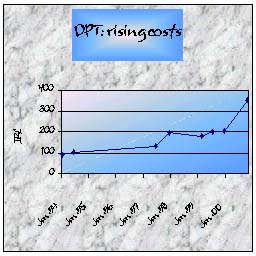 October
2000: £353 million
October
2000: £353 millionLatest NewsDPT contract awardedMarino residents stop Port Tunnel drilling |
DPT in the newsIrish TimesIrish ExaminerRTE NewsCity Wide News |
 October
2000: £353 million
October
2000: £353 millionI welcome contribution's to this page from other DPT activists.
All over the world, from San Francisco to Birmingham, it has been shown time and time again that building more roads leads to more traffic with all its attendant disadvantages (parking problems, increased pollution, traffic jams in city centres where the new roads all meet, increased frustration, lack of investment in public transport etc.). The tendency for this type of road to become a "fast-track" for non-port traffic has already been demonstrated by calls to scrap the planned tolling of car traffic.
We have believed for a long time that the best solution to the HGV problem in Dublin lies in linking the port to where this type of traffic was coming from - the Heuston Station area where the main roads from Cork, Limerick, Waterford and Galway converge with the C-Ring motorway. Now even the Environmental Impact Statement agrees with our common-sense approach by stating that "The relative economic benefit of the Royal Canal Route and the Northern Port Access Route is more finely balanced. The canal route is significantly cheaper and in 'value for money' terms performs better, with a higher benefit / cost ratio and internal rate of return." (EIS Vol1, Pg7) Value-for-money is the measure recommended for use in all public sector projects while private sector investments generally use internal rate of return on investment (IRR). It goes on to state that using the Net Present Value (NPV) method, the DPT comes out on top but this depends entirely on dubious benefit measurements leading up to the year 2030 (EIS Vol3 App J).
Firstly it has already been calculated that the DPT will necessitate
the construction of another bridge across the Liffey to the east of the
East Link. This will add further expense. The
southern leg of the Eastern Bypass is inevitable if the DPT goes ahead
(this has been admitted privately by members of the project team). The attitude
is that since the Eastern Bypass has twice
been rejected by the democratically elected Corporation, it will be
approved (& built) in a piecemeal fashion. Extra expenditure is inevitable.
Dublin Corporation will be liable for all claims after completion.
The DTI recomended that a single carriageway tunnel be constructed. The DTI interim report gave no hint of recomending any north-south tunnel.
NATM has had disastrous consequences around the world in similar ground
conditions (not just in London clays). Dublin Corporation said they would
issue a list of the UK HSE report recommendations and how they were being
addressed - they have not done so.
But any form of tunnelling under the old houses in Marino is highly questionable
- why not use one of the other routes. It is clear from the EIS etc. that
like was not being compared with like. In addition experts have claimed
that the geological conditions are unsuitable.
The only consultation which took place until the reannouncement of this project was with those known to be in favour of it. Consultation which has taken place in the last two years was an attempt to push the DPT through with no change whatsoever. Consultation with residents' groups wasat one point unilaterlly suspended by the City Manager. Funding and study visits for residents' groups has been consistently refused.
Problems with location, noise and air pollution.
Same as Northern but also very sensitive to tolling as projected traffic reduction on the East Wall Road only amounts to 5% while the DPT will add an extra dual carriageway next to this residential area. Why is the portal not in the port itself rather than between a residential and recreational areas.
Will it be used to further extend the Port or fill in the bay at Clontarf? We say no!!
Fairview Park, the single major local public amenity, would suffer long-term disruption.
All along the route, there have been massive protest meetings and petitions signed.